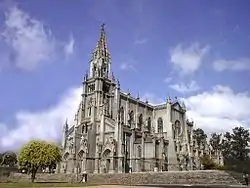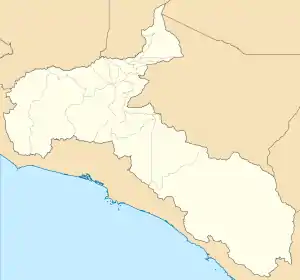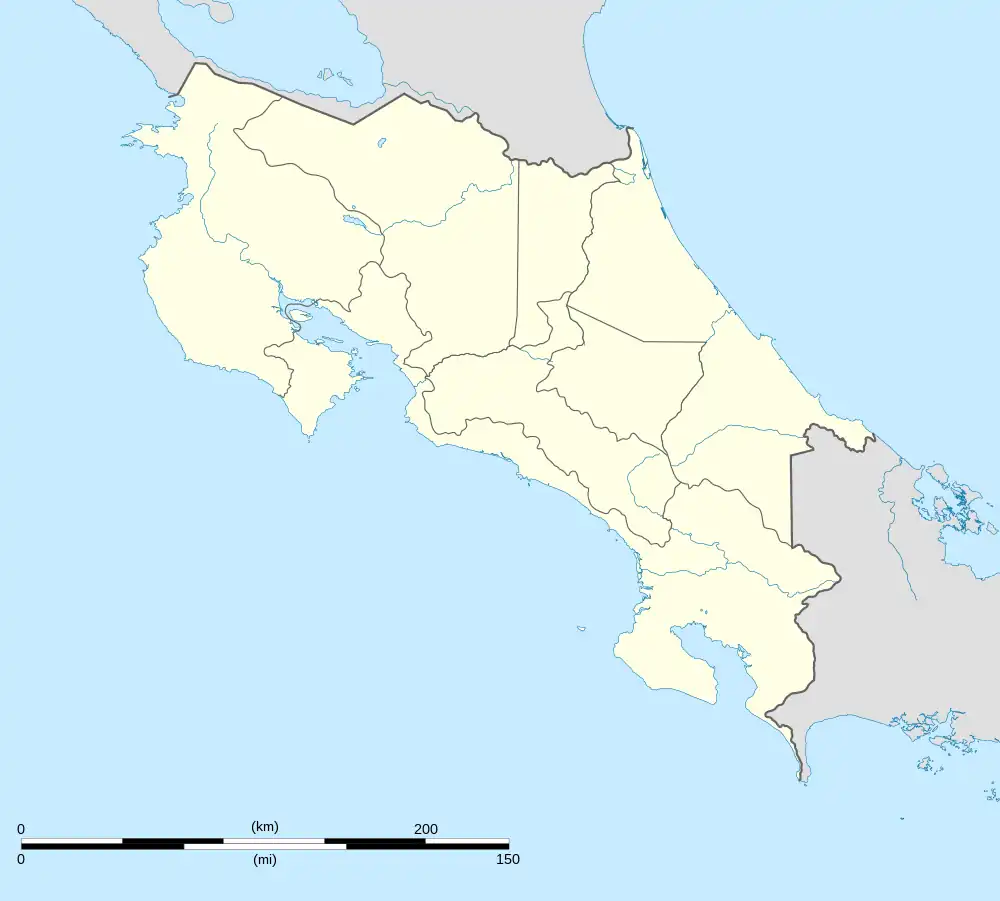Vázquez de Coronado | |
|---|---|
 Church of San Isidro de Coronado | |
 Flag  Seal | |
| Nickname: Coronado | |
Vázquez de Coronado canton | |
 Vázquez de Coronado Vázquez de Coronado canton location in San José Province  Vázquez de Coronado Vázquez de Coronado canton location in Costa Rica | |
| Coordinates: 10°04′33″N 83°56′53″W / 10.0759249°N 83.948042°W | |
| Country | |
| Province | San José |
| Creation | 15 November 1910[1] |
| Local Celebration | 15 May Saint Isidro Labrador's Day |
| Head city | San Isidro |
| Districts | |
| Government | |
| • Type | Municipality |
| • Body | Municipalidad de Vázquez de Coronado |
| • Mayor | Rolando Méndez Soto (PRSC) |
| Area | |
| • Total | 222.2 km2 (85.8 sq mi) |
| Elevation | 1,414 m (4,639 ft) |
| Population (2011) | |
| • Total | 60,486 |
| • Density | 270/km2 (710/sq mi) |
| Time zone | UTC−06:00 |
| Canton code | 111 |
| Website | www |
Vázquez de Coronado, and commonly known just as Coronado, is the eleventh canton in the province of San José in Costa Rica. The head city of the canton is San Isidro.[2][3]
Toponymy
Named in honor of the first Spanish colonial governor of Costa Rica, Juan Vázquez de Coronado, nephew of the famous explorer Francisco Vázquez de Coronado.
History
Vázquez de Coronado was created on 15 November 1910 by decree 17.[3]
Geography

Vázquez de Coronado has an area of 222.2 km2[4] and a mean elevation of 1,414 metres.[2]
The canton of the highlands rises out of the suburbs of San José to encompass a major portion of the Cordillera Central (Central Mountain Range) and Braulio Carrillo National Park. The Sucio River forms the western boundary of the canton, while the Macho, Zurquí and Patria rivers establish the canton's limits to the east. The northern tip of the canton is marked by the confluence of the Sucio and Patria rivers.
The canton is geologically formed from volcanic materials associated with the Irazu and Barva volcanoes. It has an irregular morphology with soils suitable for agriculture and dairy farming.
Coronado has a maximum altitude of 1,510 m in San Rafael district and a minimum of 1,335 m in Patalillo district. The canton has rivers that descend to the Atlantic seaboard such as Sucio, Patria and Zurquí that also serve as boundaries with the provinces of Cartago, Heredia and the canton of Moravia respectively.
In the Pacific slope, the rivers Agra, Ipís and the Virilla and its tributaries (Durazno, Macho, Quebrada Varela). The rivers Ipís, Durazno and Macho serve as boundaries of the canton, the first two with Goicoechea and the last with Moravia.
Climate
The canton has high rainfall and a typical mountain climate, in fact, many Costa Ricans traditionally associate this canton with its cold climate.
Districts
The canton of Vázquez de Coronado is subdivided into the following districts:
Demographics
| Historical population | |||
|---|---|---|---|
| Census | Pop. | %± | |
| 1927 | 4,161 | — | |
| 1950 | 6,124 | 47.2% | |
| 1963 | 10,615 | 73.3% | |
| 1973 | 16,336 | 53.9% | |
| 1984 | 24,514 | 50.1% | |
| 2000 | 55,585 | 126.7% | |
| 2011 | 60,486 | 8.8% | |
|
Instituto Nacional de Estadística y Censos[5] |
|||
For the 2011 census, Vázquez de Coronado had a population of 60,486 inhabitants.[7]
Economy
The main economic activities include dairy farming, dairy and agribusiness, coffee and other agricultural products, trade, and services such tourism. The municipality has a vibrant commercial activity of the most diverse nature which involves factories, supermarkets, grocery stores, private health services, agro-veterinary services, bank branches, clothing and footwear, electrical shops, restaurants, video stores, bars and more.
Public Services
Since the fire that affected Dr. Rafael Calderon Guardia Hospital Nacional in 2005, the Coronado Integrated Health Center serves 24-hour emergency and outpatient. Emergencies of all kinds are served and the center supports Goicoechea and Moravia cantons that do not have emergency services 24 hours, or on Saturdays, Sundays or holidays. Currently the Directorate Medical Center is in charge of Dr. Rojas Cerna, and coordination of emergency services is in charge of Soto Porras, Charpantier and Rivera doctors.
Institutions
The canton of Coronado is home to important institutions such as :
- Inter-American Institute for Cooperation on Agriculture (IICA)
- National Olympic Committee
- Research Institute Clodomiro Picado Twight of the Faculty of Microbiology of the University of Costa Rica, dedicated to research with snakes and serums against the venom of these animals
- Nursing home of the Missionaries of Charity in turn serves as a base of operations in Central America
- Coronado Day Center for Seniors
- Self-Advocates Health Association of Coronado, who owns the Home Institution Saving alcoholic and drug addict Coronado, where treatment is given on additions
- National Council for Scientific and Technological Research (CONICIT)
Transportation
Road transportation
The canton is covered by the following road routes:
References
- ↑ Hernández, Hermógenes (1985). Costa Rica: evolución territorial y principales censos de población 1502 - 1984 (in Spanish) (1 ed.). San José: Editorial Universidad Estatal a Distancia. pp. 164–173. ISBN 9977-64-243-5. Retrieved 5 October 2020.
- 1 2 "Declara oficial para efectos administrativos, la aprobación de la División Territorial Administrativa de la República N°41548-MGP". Sistema Costarricense de Información Jurídica (in Spanish). 19 March 2019. Retrieved 26 September 2020.
- 1 2 División Territorial Administrativa de la República de Costa Rica (PDF) (in Spanish). Editorial Digital de la Imprenta Nacional. 8 March 2017. ISBN 978-9977-58-477-5.
- ↑ "Área en kilómetros cuadrados, según provincia, cantón y distrito administrativo". Instituto Nacional de Estadística y Censos (in Spanish). Retrieved 26 September 2020.
- ↑ "Instituto Nacional de Estadística y Censos" (in Spanish).
- ↑ "Sistema de Consulta de a Bases de Datos Estadísticas". Centro Centroamericano de Población (in Spanish).
- ↑ "Censo. 2011. Población total por zona y sexo, según provincia, cantón y distrito". Instituto Nacional de Estadística y Censos (in Spanish). Retrieved 26 September 2020.